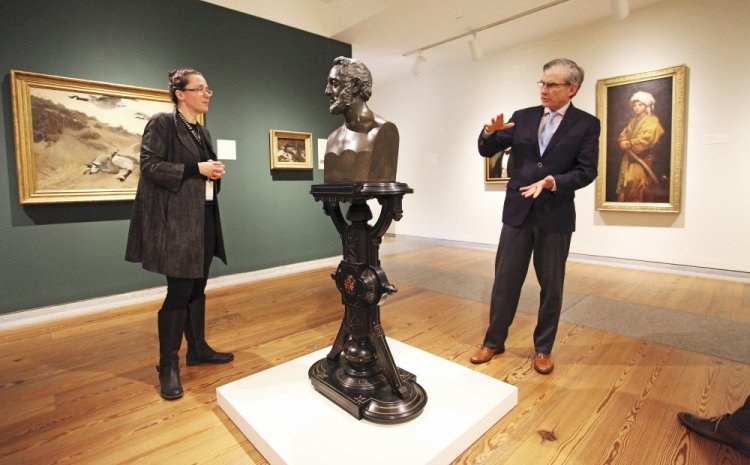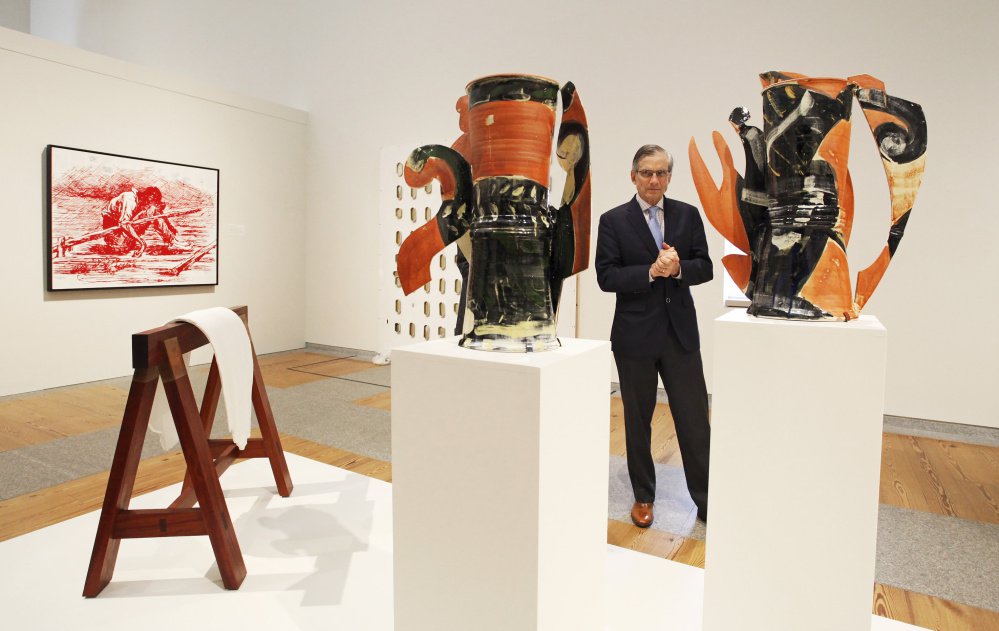William “Bro” Adams, chairman of the National Endowment for the Humanities, returned to Maine on Friday to see how his agency’s money is being spent in his home state. Adams, who lives in Falmouth and is a former president of Colby College, got a private tour of the newly reinstalled galleries of the Portland Museum of Art on Friday morning.
The NEH gave the museum $400,000 for the gallery project, which was completed in January when the museum closed for a month.
“We know that art builds community, and we know that art builds the economy,” Adams said. “Art is so much a part of the life of Maine, and Portland is the place in Maine where people come to experience it. Our investment helps give people more access to great art.”
Adams became chairman of the National Endowment for the Humanities after he retired from Colby in 2014. Federal arts funding is under review by the Trump administration, which is advocating for deep cuts in the arts and humanities. Adams’ agency awarded $1.65 million in Maine in 2016 through the Maine Humanities Council. It has spent $2.9 million in Maine since 2014.
Adams, who was appointed by former President Obama, steered clear of political talk Friday, saying only: “I’m going to be at the NEH until I’m not at the NEH anymore, and I’ll see this through to whatever point it makes sense. And after that, I’ll come back to Maine.”
He toured the museum Friday morning with Director Mark Bessire, Chief Curator Jessica May and Christi Lumiere, the museum’s interim director of development. They wanted to show Adams how they spent the NEH money.
“It’s the perfect example of the power of the NEH reaching a rural state like Maine and having a major impact,” Bessire said. “We have such a strong collection, and the NEH money gave us the time to really think about how we present the art and tell stories about the past, the present and the future of art in Maine and how it fits into the national and international conversations.”
The museum closed for a month in January to make physical improvements throughout the building. With the NEH money, it purchased period-appropriate pedestals for sculptures, constructed temporary walls and created new exhibition space in different parts of the museum, all with a goal of putting more art on view. May told Adams the museum is showing about 20 percent more art than before.
The changes were part of a multiyear, $2.7 million project called “Your Museum, Reimagined,” which fits into a larger ongoing effort by the museum to stay relevant and interesting to members and first-time viewers.
Adams was impressed with what he saw on Friday. “This is a knockout!” he gushed, as he paused in a gallery dedicated to American Modernism.
Standing behind him, May raised her arm in jubilant celebration.
Surrounded by paintings by John Marin and Marsden Hartley, Adams took note of a 1958 Andrew Wyeth egg tempera titled “River Cove.”
“We got this a year and a half ago,” Bessire said, noting that it was a gift from David Rockefeller in memory of his son. It’s a contemplative painting of a jetty near the late artist’s home in Cushing. It shows water rippling on a sandy, shell-strewn outlet, with a spruce tree reflected in the water from overhead. The painting is a bit of mystery. The reflection of the tree is so tightly rendered, it plays with the viewer’s perspective. It takes awhile to understand what you’re seeing.
Wyeth painted it during the height of the abstract movement that was popular in America at the time, Bessire told Adams. “This is his response to what was happening in New York in 1958,” he said.
Adams also appreciated a gallery housing paintings donated by his longtime friend, the painter Alex Katz, who through his foundation has purchased dozens of paintings by living artists for museums across the country. The Portland Museum of Art has received several paintings, as has the Colby College Museum of Art in Waterville. Adams got to know Katz personally during his presidency in Colby.
“Good for Alex,” he said, clearly pleased.
Near the end of his tour, Adams bumped into a student group from Crescent Elementary School in Bethel. He talked to them for a few minutes, welcoming them to the museum. He then posed for photos in front of a large wood-carving by Bernard Langlais.
Before departing, he said he was pleased the NEH helped the museum realize its vision. “We can have a big impact on these regional museums,” he said. “A little money goes a long way at a regional museum like the Portland Museum of Art, which is so much more significant in the lives of local citizens than the giant urban museums.”
Bob Keyes can be contacted at 791-6457 or at:
bkeyes@pressherald.com
Twitter: pphbkeyes
Send questions/comments to the editors.






Comments are no longer available on this story